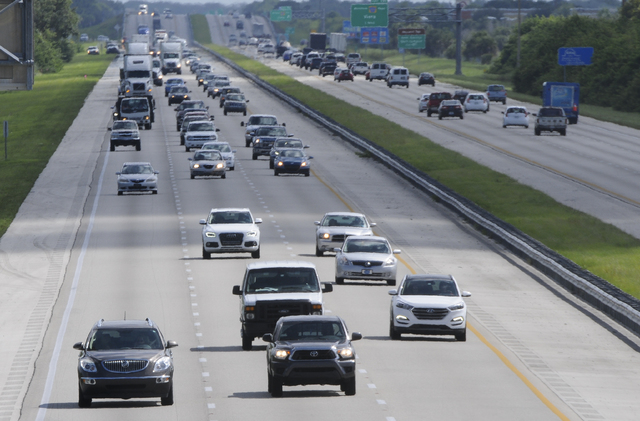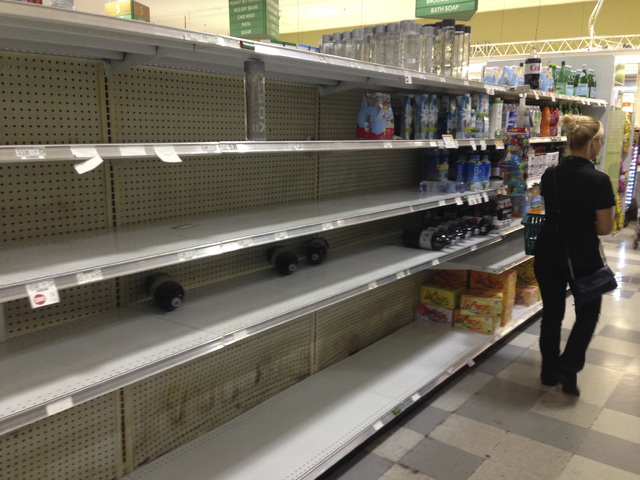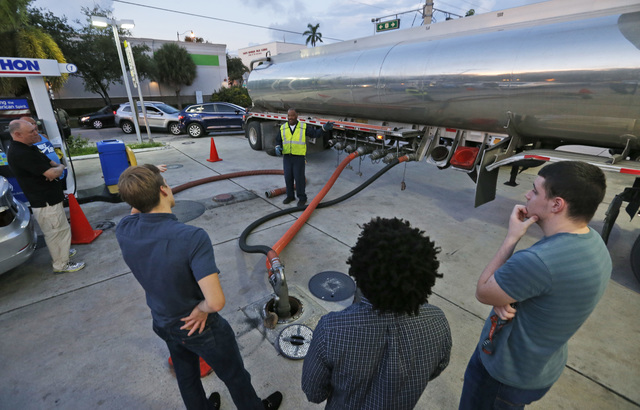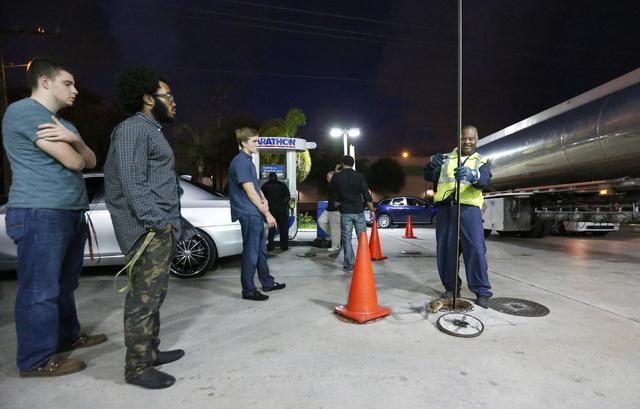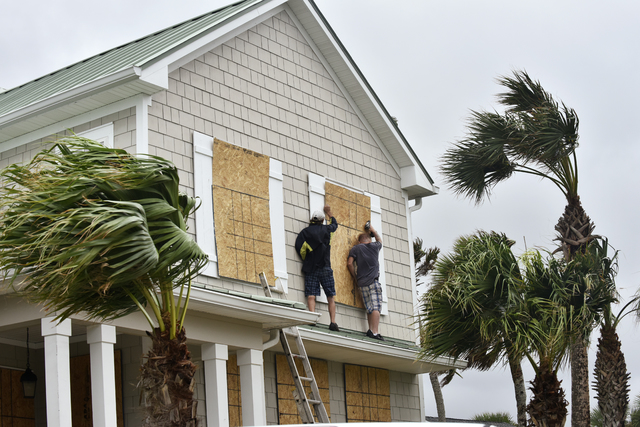Hurricane Matthew upgraded to Category 4; 2M warned to evacuate
CAPE CANAVERAL, Fla. — Leaving more than 100 dead in its wake across the Caribbean, Hurricane Matthew steamed toward heavily populated Florida with terrifying winds of 140 mph Thursday, and 2 million people across the Southeast were warned to flee inland.
It was the most powerful storm to threaten the U.S. Atlantic coast in more than a decade.
“The storm has already killed people. We should expect the same impact in Florida,” Gov. Rick Scott said as the skies began darkening from Matthew’s outer bands of rain.
The hurricane gained fury as it closed in, growing from a possibly devastating Category 3 storm to a potentially catastrophic Category 4 by late morning.
Station cameras captured new views of Hurricane Matthew today as the Category 3 storm moved to the north of Cuba. https://t.co/o31A3KRf0A pic.twitter.com/LZCruVhixe
— Intl. Space Station (@Space_Station) October 5, 2016
The station has been flying over #HurricaneMatthew all week while the crew studied life science. https://t.co/0MqHeOBiMa pic.twitter.com/hW7aXOPICT
— Intl. Space Station (@Space_Station) October 6, 2016
It was expected to scrape nearly the entire length of Florida’s Atlantic coast beginning Thursday evening. From there, forecasters said it would most likely push along the coast of Georgia and South Carolina before veering out to sea — perhaps even looping back toward Florida in the middle of next week as a tropical storm.
Millions of people in Florida, Georgia and South Carolina were told to evacuate their homes, and interstate highways were turned into one-way routes to speed the exodus. Scott said Florida could be looking at its biggest evacuation ever.
Many boarded up their homes and businesses and left them to the mercy of the storm.
Daniel Myras, who has lived for 25 years in Daytona Beach, where he owns the Cruisin Cafe two blocks from the boardwalk, struggled to find enough plywood to protect his restaurant.
“We’re not going to take any chances on this one,” he said.
He added: “A lot of people here, they laugh, and say they’ve been through storms before and they’re not worried. But I think this is the one that’s going to give us a wake-up call.”
President Barack Obama declared a state of emergency for Florida, freeing up federal money and personnel to protect lives and property.
The Fort Lauderdale airport shut down, and the Orlando airport planned to do so as well. Airlines canceled more than 2,800 flights Thursday and Friday, many of them in or out of Miami and Fort Lauderdale.
Amtrak suspended train service between Miami and New York, and cruise lines rerouted ships to avoid the storm, which in some cases will mean more days at sea.
In inland Orlando, Walt Disney World, Universal Studios and SeaWorld announced plans to close early.
Patients were transferred from two Florida waterfront hospitals and a nursing home near Daytona Beach to safer locations.
Hotels inland in places such as Charlotte, North Carolina, reported brisk business.
Forecasters said Matthew’s fiercest winds appeared unlikely to strike Miami or Fort Lauderdale, the most densely populated areas in Florida, with about 4.4 million residents. Those cities were expected to get tropical storm-force winds of between 39 mph and 73 mph.
Instead, forecasters said the West Palm Beach and Cape Canaveral areas farther north could get the brunt of the storm. More than 1.3 million people live in Palm Beach County and about 568,000 in Brevard County, home to Cape Canaveral and NASA’s Kennedy Space Center.
The last Category 3 storm or higher to hit the U.S. was Wilma in October 2005. It sliced across Florida with 120 mph winds, killing five people and causing an estimated $21 billion in damage.
As people hurried to higher ground, authorities in South Carolina said a motorist died on Wednesday after being shot by deputies in a gun battle that erupted when he sped away from a checkpoint along a storm evacuation route.
Matthew killed at least 114 people as it roared through the Caribbean. Officials said at least 108 of those deaths were in desperately poor Haiti, where many towns were cut off by the storm and the magnitude of the disaster was just beginning to come into focus two days later.
In the Bahamas, authorities reported many downed trees and power lines but no immediate deaths.
As of 2 p.m. EDT, Matthew was 125 miles southeast of West Palm Beach, Florida, moving toward the city at about 14 mph.
With hurricane-force winds extending outward up to 60 miles from the storm’s center, Matthew could wreak havoc along the coast even if it were to stay just offshore.
Forecasters said it could dump up to 15 inches of rain in some spots and cause a storm surge of 9 feet.
They said the major threat to the Southeast would not be the punishing winds — which newer buildings can withstand — but the massive surge of seawater that could wash over coastal communities.
The Miami-based National Hurricane Center said life-threatening flooding could happen along some 500 miles of coastline from Boca Raton in South Florida all the way to the Charleston, South Carolina, area.
Georgia Gov. Nathan Deal ordered a mandatory evacuation of the entire Georgia coast, covering more than a half-million people. The Georgia coast hasn’t seen a hurricane evacuation since 1999, when it narrowly escaped Floyd.
Among the coastal communities in danger were two of the South’s most historic and handsome cities, with many beautifully maintained antebellum homes: Charleston, which got slammed by Hurricane Hugo in 1989, and Savannah, Georgia, which last took a direct hit from a major hurricane in 1898.
“Hurricane Matthew is a storm not to be messed with,” Savannah Mayor Eddie DeLoach said. “If you decide to ride it out, do not expect us to be there to help you.”
President Barack Obama has declared an emergency in South Carolina and has ordered federal aid to help respond to Hurricane Matthew.
Earlier Thursday, Obama made the declaration for Florida. Obama’s action authorizes the Department of Homeland Security and the Federal Emergency Management Agency to coordinate efforts to protect lives, property and alleviate the suffering caused by the hurricane.
Emergency declarations are designed to help provide emergency services to protect lives and property, and to lessen the threat of a catastrophe.



